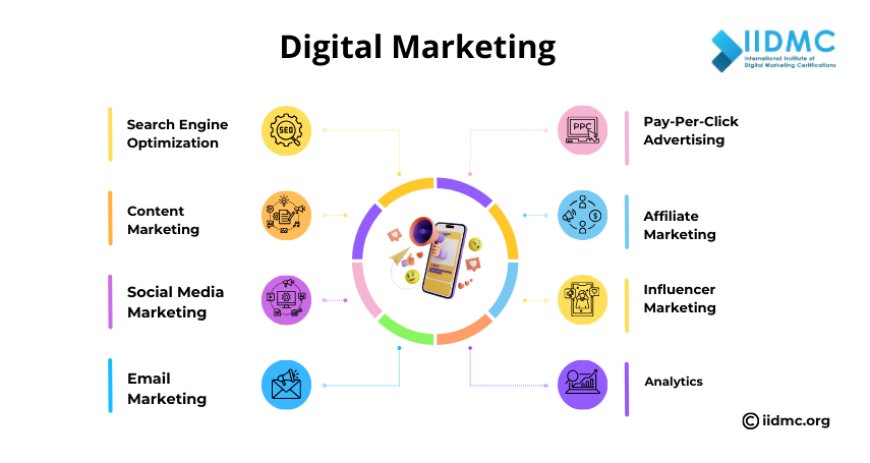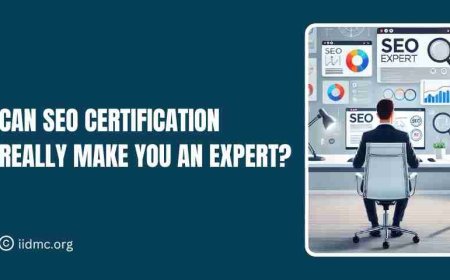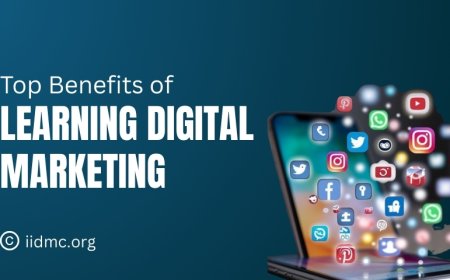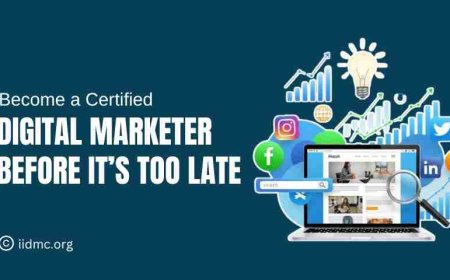What are Key Digital Marketing Opportunities
Explore key digital marketing opportunities to enhance your business. Discover the latest trends, strategies, and tools that can help you maximize your online presence and drive growth.

What are Key Digital Marketing Opportunities
Identifying key opportunities can set the stage for success. With businesses striving to establish a strong online presence, digital marketing has become crucial in reaching target audiences effectively. This blog delves into the prominent opportunities within digital marketing, offering insights into how you can leverage these strategies to stay ahead in the competitive world. From harnessing the power of social media to optimizing search engine strategies, we'll explore the essential avenues that can drive growth and enhance your marketing efforts. Whether you're a seasoned marketer or just starting out, understanding these key opportunities will help you maximize your impact and achieve your marketing goals.
Digital Marketing
Digital marketing includes all marketing efforts that use electronic devices or the internet to reach consumers. It involves a range of online strategies and tools designed to promote products or services, engage with audiences, and improve sales. Unlike traditional marketing, which relies on offline methods like print ads and TV commercials, digital marketing leverages digital channels to connect with potential customers.Digital marketing uses online channels and devices to promote products and services. It involves various strategies:
-
Search Engine Optimization (SEO): Enhances website visibility in search engines.
-
Content Marketing: Creates valuable content to attract and engage audiences.
-
Social Media Marketing: Promotes brands through platforms like Facebook and Instagram.
-
Email Marketing: Sends targeted emails to nurture customer relationships.
-
Pay-Per-Click Advertising (PPC): Displays ads where you pay per click, such as on Google Ads.
-
Affiliate Marketing: Partners with affiliates to drive sales through referrals.
-
Influencer Marketing: Uses influencers to reach and engage their followers.
-
Analytics: Tracks and analyzes data to improve marketing effectiveness.
Digital marketing connects businesses with their audience online, offering measurable and cost-effective promotional methods.

Importance of Identifying Key Opportunities to Stay Competitive
- Adapt to Market Changes
-
Identifying key opportunities helps businesses adapt to evolving market trends and consumer behaviors. Staying ahead of these changes ensures relevance and competitiveness.
- Optimize Resource Allocation
-
Recognizing valuable opportunities allows businesses to allocate resources effectively, focusing efforts on high-impact areas and maximizing returns on investment.
- Drive Innovation
-
Spotting opportunities develop innovation by encouraging the development of new products, services, or strategies, keeping the business at the forefront of industry advancements.
-
Enhance Customer Engagement
-
By understanding and capitalizing on key opportunities, businesses can better meet customer needs and preferences, leading to increased satisfaction and loyalty.
-
Gain a Competitive Edge
-
Identifying and seizing opportunities enables businesses to differentiate themselves from competitors, offering unique value propositions and capturing market share.
-
Expand Market Reach
-
Recognizing growth opportunities helps businesses explore new markets or customer segments, broadening their reach and potential for increased revenue.
-
Improve Decision-Making
-
A clear understanding of key opportunities enhances strategic decision-making, allowing businesses to make informed choices that align with their goals and market dynamics.
Content Marketing
Content marketing is a strategic approach focused on creating and sharing valuable content to attract and engage a target audience. Its aim is to drive profitable customer actions by providing information that meets their needs or interests.
Benefits:
-
Drives Traffic: Quality content improves search engine rankings and attracts visitors to your website.
-
Generates Leads: Engaging content encourages actions like subscribing to newsletters or downloading resources, turning visitors into leads.
-
Builds Brand Authority: Consistent, valuable content establishes your brand as a trusted industry expert, enhancing credibility.
Strategies:
-
Blogging: Regular, insightful blog posts boost SEO, draw in visitors, and position your brand as a thought leader.
-
Video Creation: Engaging videos capture attention and can be shared across platforms, increasing reach and interaction.
-
Infographics: Visual content simplifies complex information, making it more shareable and engaging, which helps in expanding visibility.
Search Engine Optimization (SEO)
SEO is the practice of optimizing a website to improve its visibility and ranking on search engine results pages (SERPs). The goal is to increase organic (non-paid) traffic by making the site more relevant and accessible to search engines and users.
Importance:
-
Enhances Visibility: SEO helps websites rank higher in search results, making them more visible to potential visitors.
-
Boosts Organic Traffic: Improved rankings drive more organic traffic to your site, increasing the chances of attracting and converting customers.
Key Techniques:
-
Keyword Research: Identifying and using relevant keywords helps ensure that your content matches what users are searching for.
-
On-Page SEO: Optimizing elements like meta tags, headers, and content enhances a page’s relevance and usability, improving its search engine ranking.
-
Backlink Building: Acquiring high-quality backlinks from reputable sites boosts your site’s authority and credibility, contributing to higher rankings.
Social Media Marketing
Social media marketing involves using platforms like Facebook, Instagram, Twitter, and LinkedIn to promote products or services, engage with an audience, and build brand awareness. It uses various social networks to achieve marketing goals and connect with potential customers.
Benefits:
-
Engagement: Social media facilitates direct interaction with your audience, developing engagement and building relationships through likes, comments, and shares.
-
Brand Building: Consistent and creative content helps establish and enhance brand identity, making your business more recognizable and memorable.
-
Reach: Social media expands your reach by allowing you to connect with a broader audience, including potential customers who might not be reached through traditional marketing channels.
Strategies:
Platform-Specific Content: Tailor content to each platform’s audience and format to maximize effectiveness and engagement.
Paid Advertising: Utilize targeted ads to reach specific demographics and drive traffic, leads, or sales.
Audience Interaction: Engage with your audience through replies, direct messages, and community management to build loyalty and develop a positive brand image.
Email Marketing
Email marketing is a strategy that involves sending targeted emails to a list of subscribers to promote products, share updates, or nurture relationships with customers. It aims to engage recipients and encourage specific actions.
Importance:
-
Effectiveness in Conversion: Email marketing can drive conversions by delivering personalized offers and calls-to-action directly to potential customers.
-
Customer Loyalty: Regular, relevant emails help maintain engagement with existing customers, developing loyalty and encouraging repeat business.
Key Tactics:
-
Building a Targeted Email List: Grow your subscriber list through sign-ups, lead magnets, and opt-ins to ensure you reach a relevant audience.
-
Personalized Content: Tailor email content based on recipient preferences, behavior, and demographics to increase engagement and effectiveness.
-
Newsletters: Send regular newsletters to keep your audience informed about updates, promotions, and valuable content, strengthening your connection with them.
Influencer Marketing
Influencer marketing involves partnering with individuals who have a significant following on social media or other platforms to promote your products or services. These influencers use their reach and credibility to endorse your brand and drive engagement.
Benefits:
-
Expanding Reach: Influencers help you tap into their established audience, increasing your brand’s visibility and reaching new potential customers.
-
Building Credibility: Endorsements from trusted influencers enhance your brand’s credibility and authenticity, as their recommendations are perceived as more genuine.
Choosing Influencers:
-
Aligning with Your Target Audience: Select influencers whose followers match your target demographic to ensure your message resonates with the right audience and drives meaningful engagement.
Pay-Per-Click (PPC) Advertising
PPC advertising is an online marketing model where advertisers pay a fee each time their ad is clicked. It’s a way to buy visits to your site, rather than earning them organically.
Benefits:
-
Targeted Traffic: PPC allows you to target specific audiences based on keywords, demographics, and interests, driving highly relevant traffic to your site.
-
Measurable Results: PPC provides detailed analytics on ad performance, enabling you to track ROI, adjust strategies, and optimize campaigns effectively.
Platforms and Strategies:
-
Google Ads: The most widely used PPC platform, where ads appear in search results and on partner sites. Utilize keyword research to bid on relevant terms.
-
Social Media Ads: Platforms like Facebook, Instagram, and LinkedIn offer targeted advertising options to reach users based on their interests and behaviors.
-
Optimization Tips: Regularly review and adjust your bids, ad copy, and targeting to improve performance. Use A/B testing to identify the most effective ads and strategies.
Data Analytics and Insights
Definition: Data analytics in digital marketing involves collecting, processing, and analyzing data to understand patterns and trends related to marketing performance. It helps businesses make informed decisions based on quantitative evidence.
Importance:
-
Understanding Audience Behavior: Data analytics provides insights into how customers interact with your digital content, allowing you to tailor strategies to better meet their needs and preferences.
-
Campaign Effectiveness: Analyzing data helps measure the success of marketing campaigns, identify what works, and determine areas for improvement, ensuring more effective future efforts.
Tools and Techniques:
-
Google Analytics: A powerful tool for tracking website traffic, user behavior, and conversion rates. It provides valuable metrics to evaluate and optimize your digital marketing strategies.
-
Performance Tracking: Monitor key performance indicators (KPIs) such as click-through rates, conversion rates, and engagement levels to gauge campaign success and adjust tactics as needed.
-
Data-Driven Decision Making: Use data insights to make informed decisions, optimize marketing strategies, and allocate resources efficiently for better results.
Exploring digital marketing opportunities like SEO, content marketing, social media, email marketing, and PPC can boost your business's reach and effectiveness. Data analytics helps refine these strategies by providing insights into audience behavior and campaign performance.
To advance your skills and stay competitive, consider certifications from the International Institute of Digital Marketing and Certification (IIDMC). Leveraging these opportunities will drive growth and success in the dynamic digital world.




























